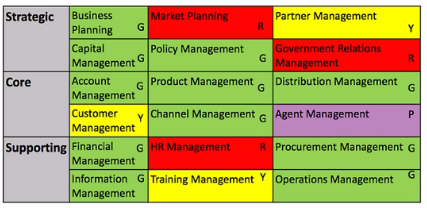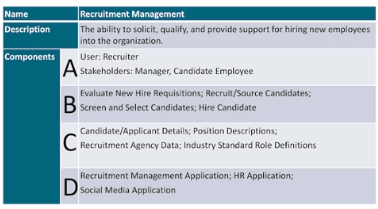Curious about Actual The Open Group TOGAF Certifications (OGB-001) Exam Questions?
Here are sample The Open Group TOGAF Business Architecture Part 1 (OGB-001) Exam questions from real exam. You can get more The Open Group TOGAF Certifications (OGB-001) Exam premium practice questions at TestInsights.
In what TOGAF ADM phase is the Information map translated into data models?
Start a Discussions
Consider the following business capability model, where cells of a model are given different colors to represent levels (note the letters G, R, Y, P also denote the colors used = Green, Red, Yellow and Purple):

Which of One following best describes the technique?
Start a Discussions
Which of the following are two concepts used for structuring a business capability model?
Correct : A
This answer is based on the TOGAF Series Guide: Business Capabilities , which states that ''A business capability model is a structured representation of the capabilities of an organization. It is typically structured using two concepts: categorizing and grouping.'' Categorizing is the process of assigning capabilities to different categories based on their nature, purpose, or function. Grouping is the process of arranging capabilities into different levels or layers based on their granularity, abstraction, or dependency. The other options are not correct, as they are not concepts used for structuring a business capability model.
Start a Discussions
Consider the following Business Capability Example:

Which of the following ore A and C?
Correct : D
This answer is based on the definition and components of a business capability as ''an ability that a business possesses to achieve a specific outcome'' . A business capability consists of four components: who, what, where, and how. Who refers to the roles or actors that perform or enable the capability. What refers to the functions or activities that constitute the capability. Where refers to the locations or channels where the capability is executed or delivered. How refers to the processes or methods that govern the capability. In the image provided by the user, A and C are examples of who and what components, respectively. Therefore, A and C are roles and information, which are two types of who and what components.
Start a Discussions
Which of the following is an end product of business capability modeling?
Correct : D
This answer is based on the definition and purpose of a business capability map as ''a technique for the representation of an organization's business anchor model, independent of the organization's structure, processes, people, or domains'' . A business capability map is an end product of business capability modeling, as it shows the complete set of capabilities that an organization possesses or requires to achieve its goals and objectives. A business capability map provides a high-level and stable view of what a business does or can do, regardless of how or where it does it. The other options are not correct, as they are not end products of business capability modeling.
Start a Discussions
Total 30 questions